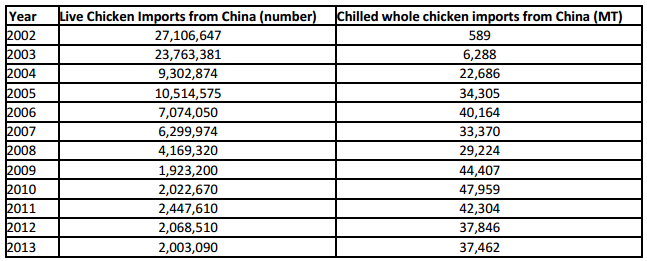The government will compensate HK$30 (US$3.85) for each culled chicken. In addition, breeders will also be given about HK$30 (US$3.85) for each chicken which are ready for the market. It is estimated that the HKG will spend about HK$17.7 million (US$2.28 million) as compensation.
Despite all this compensation, the industry was dissatisfied that all live chicken businesses were suspended when local supplies were not found with the avian influenza (AI) virus. They voiced their disappointment that the entire ban on live chicken trade could have been avoided if there was a separate site for holding imported chickens while AI test results were awaited. Following the culling of the chickens in the wholesale market in January, the industry renewed their urge to provide such a site for holding imported chickens.
The government responded to their request this time. The HKG reopened the wholesale market on February 19 resuming the sales of local supplies. However, the ban on imports of live chickens from China will continue for another four months. The HKG explained that they are looking for a suitable site for holding imported chickens, which will no longer be mixed with local supplies before they are confirmed to be free of AI virus. The whole exercise including the installation of facilities will take four months.
Market Reaction:
It was estimated that about 600,000 chickens have been stocked up in farms after three weeks of trade suspension and the high stock should put pressure on prices. However, the news that the ban on live chicken supplies from China will be expanded for four months has boosted the market price. The wholesale price of live chicken on the first day of market resumption was as high as HK$23/catty (US$4.90/kg), about 60 percent over the pre-banned average price of HK$14/catty (US$3/kg).
Hong Kong currently has a daily supply of chicken around 18,000 heads, 12,000 of which come from local farms and the rest from registered farms in China.
Over a decade ago, the daily supplies of live chicken amounted to over 100,000 heads and imports from China accounted for over 70 percent.
To reduce the risk of AI outbreak, starting early 2000s, the HKG adopted administrative measures to reduce the number of live chicken supplies and started to allow the imports of chilled whole chickens from China as substitutes. The table below shows the gradual shift of consumption pattern.
Table: Hong Kong’s Live Chicken Imports from China vs Chilled Whole Chicken Imports

Source : Hong Kong Census and Statistics Department





